MaryAnn Bernal's Blog, page 160
July 31, 2015
Analysis of Viking burial site reveals the harshness of life in early Christian Iceland
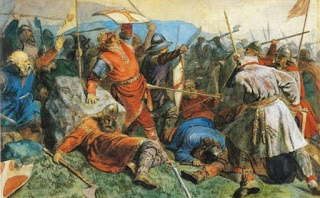 Bones reveal life was harsh in early Christian Iceland. (
Wikimedia Commons
)
Bones reveal life was harsh in early Christian Iceland. (
Wikimedia Commons
)Ancient Origins
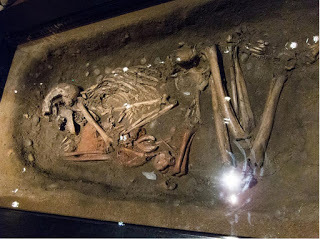
Early Viking settlers in Iceland were Pagan worshippers of the Aesir, the family of gods that included Thor and Odin. However in 1,000 AD Iceland converted to Christianity by decree of the country’s National Assembly under the rule of Olaf Tryggvason. This in turn resulted in a change in burial customs, such that the deceased began to be buried in cemeteries organized around a church. New research conducted by bioarchaeologists Guđný Zoëga and Kimmarie Murphy has revealed just how harsh life at that time was.
The two scientists investigated a small cemetery near a farm called Keldudalur in the Skagafjörđur region of northern Iceland. The site dates from the early 11th century and features 52 burials, probably of three to five generations of one farming family.
The archaeologists unearthed 27 bodies at the site. The men were buried in the southern half of the cemetery and women in the northern half. A high rate of infant mortality was discovered. Once an individual had reached the age of 30 life became more precarious and not many older people survived for long.
Many of the deceased had suffered from porotic hyperostosis, which is evidenced by the presence of spongy or porous bone tissue and holes in the cranium, and is a result of suffering from anemia. The archaeologists concluded that this couldn’t have been iron-deficiency anemia since the people here typically had a diet high in meat. This meant they must have had other gastrointestinal conditions or dietary deficiencies including, in one individual, scurvy.
The story of Ragnarok and the Apocalypse Baldr: The Shining God Who Shines No More The long goodbye to Scandinavian Paganism and the Christianization of three realms These early Icelanders were pastoral farmers who planted grain but also relied on sheep and cattle to survive more difficult times. Most of the settlements were widely dispersed, rather than the larger communities in other areas settled by the Vikings. These settlements usually consisted of a group of buildings surrounded by fences, outside of which were the fields farmed by the inhabitants and areas of pasture land. When Iceland became Christian, small churches began to be constructed on these farms with accompanying cemeteries.
 Traditional Viking Chieftain funerals were energetically observed, with drinking, feasting, and sacrificial slaughter. Later, people would be buried in cemeteries near churches. “The Funeral of a Viking,” painting by Frank Dicksee, 1893 (Wikiart photo)Many of the adults suffered from degenerative joint disease, probably as a result of the rigors of their farming lifestyle. This was common in both men and women, given that everybody helped in the work. The bodies are notable for the lack of dental caries, suggesting a high dairy intake, although this can also result in gingivitis, plaque, and infections and tooth loss, all of which were observable.
Traditional Viking Chieftain funerals were energetically observed, with drinking, feasting, and sacrificial slaughter. Later, people would be buried in cemeteries near churches. “The Funeral of a Viking,” painting by Frank Dicksee, 1893 (Wikiart photo)Many of the adults suffered from degenerative joint disease, probably as a result of the rigors of their farming lifestyle. This was common in both men and women, given that everybody helped in the work. The bodies are notable for the lack of dental caries, suggesting a high dairy intake, although this can also result in gingivitis, plaque, and infections and tooth loss, all of which were observable.Bioarchaeologist Cecilia Collins told Forbes that the investigation has helped understanding of the lives of families and communities on the edge of the Arctic. It also helps to reduce the stereotype of the Vikings as marauding and violent. The people buried at Keldudalur experienced lives that were unpredictable from one season to the next. They also regularly experienced foot shortages, disease and injury from hard physical work.
Did a Native American travel with the Vikings and arrive in Iceland centuries before Columbus set sail? Viking Longhouse Discovery Rewrites the History of Icelandic Capital City The 10th century chronicle of the violent, orgiastic funeral of a Viking chieftain
 Early peoples regularly experienced foot shortages, disease, and injury from hard physical work. (Hans Splinter/
CC BY-ND 2.0
)Zoëga and Murphy have now presented their findings in a research article for the International Journal of Osteoarchaeology.
Early peoples regularly experienced foot shortages, disease, and injury from hard physical work. (Hans Splinter/
CC BY-ND 2.0
)Zoëga and Murphy have now presented their findings in a research article for the International Journal of Osteoarchaeology.Featured Image: A Viking grave. New studies on bones reflect the harsh conditions many endured. Representational image. (Thomas Quine/ CC BY 2.0 )
By Robin Whitlock
Published on July 31, 2015 16:39
Prehistoric fortress island discovered on English-Welsh border
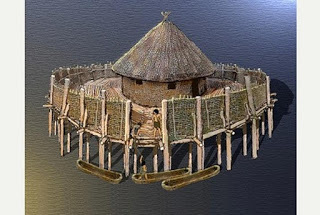 Ancient Origins
Ancient OriginsArchaeologists excavating a modern housing estate on the English-Welsh border in Monmouth, UK, have discovered an ancient fortress consisting of a wooden island with a fortified farmhouse elevated above the ground on stilts. The structure used to stand above the waters of an ice age lake and may be older than Stonehenge or the Egyptian pyramids. The structure, known as a ‘crannog’, has been dated to 4,900 years ago. The lake surrounding it would have served as a natural defence against attackers.
“We never thought the timbers were as old as they are, it's an amazing discovery” said archaeologist Steve Clarke, speaking to the Western Daily Press. “The inhabitants would have been surrounded by water up to ten feet deep and there's no evidence of a walkway so it was probably only accessible by canoe. This is surely one of the most stunning of prehistoric discoveries. An exceptional feature is that the construction was based on three massive parallel "sleeper beams" – timbers roughly hewn from complete trees set in the ground horizontally”
 A reconstructed crannog near Kenmore, Perth and Kinross, on Loch Tay, Scotland (
Wikimedia Commons
)Mr Clarke added that the farmhouse was occupied at around the time when humans in Britain first started to live communally and is only the second such structure to be discovered in England and Wales, being much older than the first. Many more of them have been discovered in Scotland, most of them dating from the Iron Age (800 BC to 100 AD). Clarke first discovered that the area had once been underwater when the foundations for the new housing estate were being laid by Barratt Homes several years ago in 2013. Three 100 foot channels, each about the width of a canoe, were found close to where Mr Clarke believes the shore of the lake would have been. These channels date from 1700 BC and are evidence of probably one of the oldest boatyards ever discovered.
A reconstructed crannog near Kenmore, Perth and Kinross, on Loch Tay, Scotland (
Wikimedia Commons
)Mr Clarke added that the farmhouse was occupied at around the time when humans in Britain first started to live communally and is only the second such structure to be discovered in England and Wales, being much older than the first. Many more of them have been discovered in Scotland, most of them dating from the Iron Age (800 BC to 100 AD). Clarke first discovered that the area had once been underwater when the foundations for the new housing estate were being laid by Barratt Homes several years ago in 2013. Three 100 foot channels, each about the width of a canoe, were found close to where Mr Clarke believes the shore of the lake would have been. These channels date from 1700 BC and are evidence of probably one of the oldest boatyards ever discovered.Clarke subsequently discovered a series of timber posts, which had once been preserved beneath the clay and peat of an ancient lagoon, formed after the lake had drained. He sent them to the Scottish Universities Environmental Research Centre for radiocarbon dating and scientists employed there informed him the posts were around 4,900 years old. At that time the ground in the area would have been under 20 foot of water, however the posts themselves were found at a location that would have been somewhat shallower, leading Mr Clarke to believe they were evidence of a crannog.
 The newly-discovered timber posts are believed to have been stilts upon which the crannog was built. Reconstructed crannog on Loch Tay, Scotland (
Wikimedia Commons
)The first crannog in the country to be discovered was at Llangorse Lake in the Brecon Beacons which is believed to have been built around 2,000 years earlier than the one now discovered at Monmouth. It stood closer to the shore and was connected to it by a wooden walkway. Reconstructions of crannogs can be seen at the Scottish Crannog Centre at Loch Tay in Perthshire.
The newly-discovered timber posts are believed to have been stilts upon which the crannog was built. Reconstructed crannog on Loch Tay, Scotland (
Wikimedia Commons
)The first crannog in the country to be discovered was at Llangorse Lake in the Brecon Beacons which is believed to have been built around 2,000 years earlier than the one now discovered at Monmouth. It stood closer to the shore and was connected to it by a wooden walkway. Reconstructions of crannogs can be seen at the Scottish Crannog Centre at Loch Tay in Perthshire.Crannogs would have been able to accommodate around 20 people who slept around against the walls, some of them in timber bunk beds. The space inside would have also featured an area for animals and a fire in the centre provided heating, light and a means of cooking food. The floor would probably have been covered with bracken.
The crannog at Monmouth would probably have been occupied by a wealthy family who would have farmed the fields nearby and gathered fruit, nuts wild cabbage and medicinal herbs from local woodlands. They would probably have hunted wild boar and other animals as well. When attacked, they would have retreated to the fort. There are over 600 such sites in Scotland.
Mr Clarke is chairman of Monmouth Archaeological Society and is also the author of The Lost Lake – Evidence of Prehistoric Boat-Building.
Featured image: An artist’s impression of the crannog at Monmouth by Peter Bere.
By Robin Whitlock
Published on July 31, 2015 16:31
History Trivia - Battle of Alexandria - Mark Antony victorious
July 31
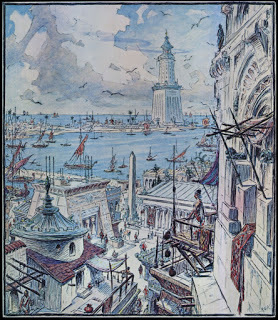
30 BC Battle of Alexandria: Mark Antony achieved a minor victory over Octavian's forces, but most of his army subsequently deserted, leading to his suicide.
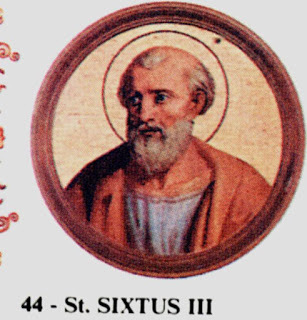
432 Saint Sixtus III was elected Roman Catholic pope. His papacy is associated with a great building expansion in Rome; Santa Maria Maggiore was built during his reign.

781 The oldest recorded eruption of Mt. Fuji (Traditional Japanese date: July 6, 781).

30 BC Battle of Alexandria: Mark Antony achieved a minor victory over Octavian's forces, but most of his army subsequently deserted, leading to his suicide.

432 Saint Sixtus III was elected Roman Catholic pope. His papacy is associated with a great building expansion in Rome; Santa Maria Maggiore was built during his reign.

781 The oldest recorded eruption of Mt. Fuji (Traditional Japanese date: July 6, 781).
Published on July 31, 2015 02:00
July 30, 2015
Book Launch - Chicken in the Oven by M.C. Arvanitis

What in the world would make a chicken smile? When Farmer Dill came to the chicken yard to choose the fattest chicken for her Sunday dinner, and when she waved her chicken hook at BFC, short for Big Fat Chicken, he certainly wasn't smiling. What could he do to convince her not to choose him to be her Chicken in the Oven?
Amazon Link
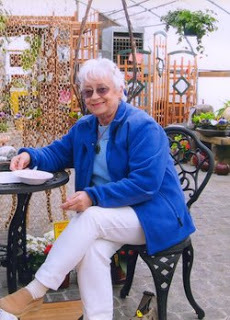 Ms. Arvanitis is a full time writer who creates books for children, mid-grade readers, and YA historical novels. Her time as a preK and early grades teacher gives her insight into the stories children like to read. She writes mid grade readers books she calls "fables." where she brings mythical creatures such as fairies, elves, mermaids, pixies, and other strange beings to her stories. She now offers her first three 'fables' for mid grader readers. 'THE LEGEND OF ELPANDA PAWS,' 'FORBIDDEN WINGS, A MERMAID'S STORY' PIXIES OF THE FERN: FERNELLA'S MAGIC,' in both as e-books and in print books.
Ms. Arvanitis is a full time writer who creates books for children, mid-grade readers, and YA historical novels. Her time as a preK and early grades teacher gives her insight into the stories children like to read. She writes mid grade readers books she calls "fables." where she brings mythical creatures such as fairies, elves, mermaids, pixies, and other strange beings to her stories. She now offers her first three 'fables' for mid grader readers. 'THE LEGEND OF ELPANDA PAWS,' 'FORBIDDEN WINGS, A MERMAID'S STORY' PIXIES OF THE FERN: FERNELLA'S MAGIC,' in both as e-books and in print books. The first two of Mrs Arvanitis's teen/YA historical series,
'HANK OF TWIN RIVERS, BOOK ONE, JOURNEY OF CHANGE'. and
'HANK OF TWIN RIVERS, BOOK TWO, THE EAGLE'S NEST' is now available as E-book and in print. This coming of age story takes place in 1855 and tells of a pioneer boy's conflict with his stern father on the Oregon Trail.
The third of the HANK OF TWIN RIVER'S SERIES
HANK OF TWIN RIVERS, BOOK THREE; RIDING WITH THE WRANGLERS' will be added to her author's list in 2015.
She also plans to expand her list of books to picture books for under six year old children. These stories have been read and enjoyed by the thousands of students she has taught though out the years. First will be 'CHICKEN IN THE OVEN', the saga of BFC who doesn't want to be Farmer's Dil's Sunday dinner.
Now retired, her life has been filled with younguns .. her own children, grandchildren, and near a thousand students through the years has spent time in her "Four to Get Ready preschool, now featured on line at her cyber preschool blog,
http://www.ms-marge.com
She would value any comments you may have on any of her books. You can email her at margaretarvanitis@gmail.com.
Published on July 30, 2015 17:25
History Trivia - Frederick I (Barbarossa) crowned King of Burgundy
July 30
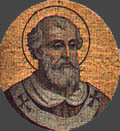
657 St Vitalian began his reign as Catholic Pope succeeding Eugene I. He was successful in improving relations with England, where the Anglo-Saxon and British clergies were divided regarding various ecclesiastical customs. At the Synod of Whitby, King Oswy of Northumberland accepted Roman practices regarding the keeping of Easter and the shape of the tonsure. Together with King Ecgberht of Kent, he sent the priest Wighard to Rome, to be consecrated in the Papal City after the death of Archbishop Deusdedit of Canterbury in 664, but Wighard died in Rome of the plague.
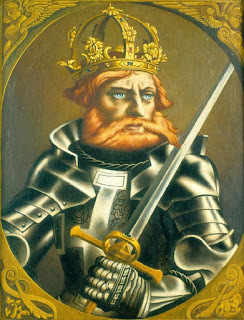
1178 Frederick I (Barbarossa), Holy Roman Emperor, was crowned King of Burgundy.
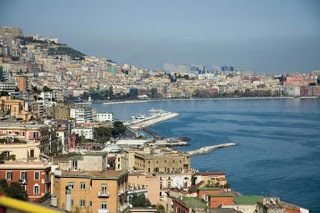
1629 An earthquake in Naples, Italy, killed about 10,000 people.

657 St Vitalian began his reign as Catholic Pope succeeding Eugene I. He was successful in improving relations with England, where the Anglo-Saxon and British clergies were divided regarding various ecclesiastical customs. At the Synod of Whitby, King Oswy of Northumberland accepted Roman practices regarding the keeping of Easter and the shape of the tonsure. Together with King Ecgberht of Kent, he sent the priest Wighard to Rome, to be consecrated in the Papal City after the death of Archbishop Deusdedit of Canterbury in 664, but Wighard died in Rome of the plague.

1178 Frederick I (Barbarossa), Holy Roman Emperor, was crowned King of Burgundy.

1629 An earthquake in Naples, Italy, killed about 10,000 people.
Published on July 30, 2015 01:30
July 29, 2015
The Rock Show with Diane Turner latest show on More Music Radio
Published on July 29, 2015 08:01
Mr. Chuckles conjures up Poet, Performer and Humourist, Lynn Gerrard while stirring the Wizard's Cauldron

The Wizard says:
I had a fiver for every person I've spoken to in the past year who has said "Marky, you ought to have that Lynn Gerrard around the Cauldron," I would now have a tidy sum in my wallet instead of holes and fresh air, so, as the second part of my poetry special, I girded my loins and got in touch with her and was delighted when she agreed to come round.
As we discussed last week during Sue Lobo's fantastic interview, after years on the fringes of the fringes (of even those fringes), poetry is making a big comeback on the scene.
Lynn writes - her new book has been well received - blogs extensively, and most excitingly, performs live poetry, which takes some proper bottle.
An extremely funny woman and a talented wordsmith, it has been a pleasure to meet her this week. I caught up with Lynn on the Wizphone backstage as she prepared for her most recent recital somewhere in the rainswept north of England - here's what she had to say. Click on this link to read the entire interview
Published on July 29, 2015 07:22
History Trivia - Saracen raiders sack Thessalonica
July 29
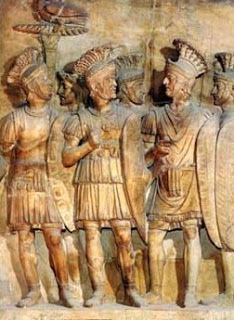
238 The Praetorian Guard stormed the palace and captured Pupienus and Balbinus. They were dragged through the streets of Rome and executed. On the same day Gordian III, age 13, was proclaimed emperor.
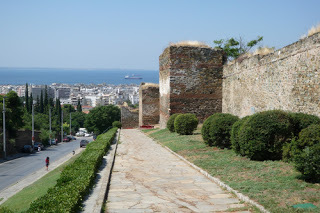
904 Sack of Thessalonica: Saracen raiders under Leo of Tripoli sacked Thessalonica, the Byzantine Empire's second-largest city, after a short siege, and plundered it for a week.
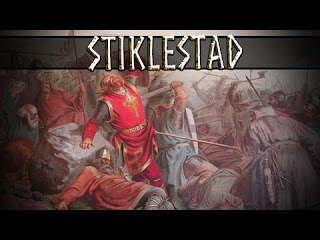
1030 Ladejarl-Fairhair succession wars: Battle of Stiklestad – King Olaf II, the patron saint of Norway, fought and died trying to regain his Norwegian throne from the Danes.

238 The Praetorian Guard stormed the palace and captured Pupienus and Balbinus. They were dragged through the streets of Rome and executed. On the same day Gordian III, age 13, was proclaimed emperor.

904 Sack of Thessalonica: Saracen raiders under Leo of Tripoli sacked Thessalonica, the Byzantine Empire's second-largest city, after a short siege, and plundered it for a week.

1030 Ladejarl-Fairhair succession wars: Battle of Stiklestad – King Olaf II, the patron saint of Norway, fought and died trying to regain his Norwegian throne from the Danes.
Published on July 29, 2015 01:30
July 28, 2015
History Trivia - potatoes introduced to Europe
July 28
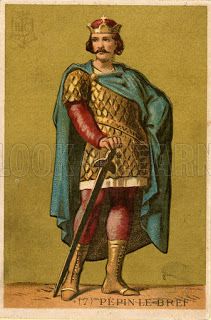
754 Pope Stephen II made Pippin the Short King of France. He was the first King of the Franks of the Carolingian dynasty.

1540 Henry VIII of England married his fifth wife, Catherine Howard.

1586 Sir Thomas Harriot introduced potatoes to Europe.

754 Pope Stephen II made Pippin the Short King of France. He was the first King of the Franks of the Carolingian dynasty.

1540 Henry VIII of England married his fifth wife, Catherine Howard.

1586 Sir Thomas Harriot introduced potatoes to Europe.
Published on July 28, 2015 02:00
July 27, 2015
History Trivia - Thomas Becket and King Henry II reconcile
July 27
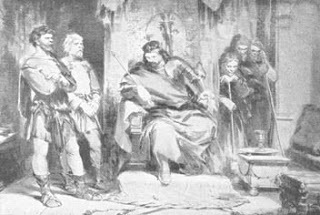
1054 Siward, Earl of Northumbria invaded Scotland to support Malcolm Canmore against Macbeth of Scotland, who usurped the Scottish throne from Malcolm's father, King Duncan. Macbeth was defeated at Dunsinane.
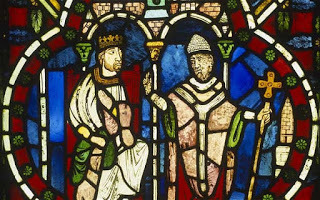
1170: Thomas Becket and King Henry II temporarily reconciled. Becket's six-year self-imposed exile from England was resolved when he met with Henry and King Louis VII of France at a conference in Freteval and settled on an uneasy truce. Becket made preparations to return to his See in Canterbury.
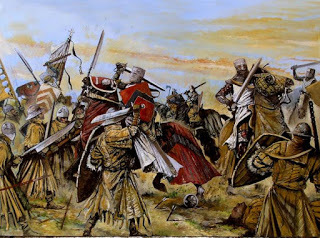
1214 King John lost Normandy and his other French possessions after being defeated by Philip II of France in the Battle of Bouvines.

1054 Siward, Earl of Northumbria invaded Scotland to support Malcolm Canmore against Macbeth of Scotland, who usurped the Scottish throne from Malcolm's father, King Duncan. Macbeth was defeated at Dunsinane.

1170: Thomas Becket and King Henry II temporarily reconciled. Becket's six-year self-imposed exile from England was resolved when he met with Henry and King Louis VII of France at a conference in Freteval and settled on an uneasy truce. Becket made preparations to return to his See in Canterbury.

1214 King John lost Normandy and his other French possessions after being defeated by Philip II of France in the Battle of Bouvines.
Published on July 27, 2015 02:00




